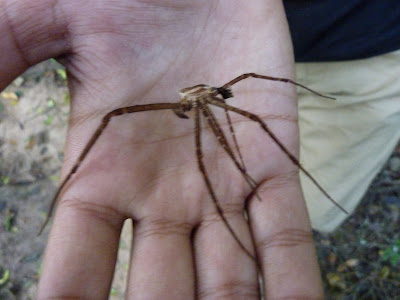When Rom first visited Agumbe in the early 1970s he had some peculiar hippie ideas. He felt that all the trappings of the human world interfered with his ability to find king cobras. So, he discarded his watch and shoes, and stripped down to his loin cloth. Not the best attire for his first brush with the Devil Nettle!Read more about the Devil Nettle in this delightful essay by Janaki Lenin. It is found in the Western Ghats. The Hindu : FEATURES / METRO PLUS : Innocent plant, deadly sting
He got it on his arms, chest, stomach and legs. “It was itchy painful,” he recalls. Hives erupted, and to alleviate the pain he dove into a pool. It became doubly horrendous and he jumped out again. That night he shivered uncontrollably. By the next morning, the hives had become depressions and the affected area was constantly clammy. For the following six months, any contact with water was enough to set off the ‘itchy pain' again.
I am glad we did not come across these in our walks in the karian shola at Parambikulam. The plant picture in The Hindu essay looks most innocuous!
While we did not get stung by nettle, a few of the group members had ticks on them, while others (including me) had chigger bites! Forewarned about leeches, we were resplendent in our leech socks, much to the amusement of our guides, who mentioned mildly several times, that there were no leeches at the moment since they had had a spell of dry weather.
On our return to Madras, I was absent-mindedly scratching my ankles, and looked down to see some red, mosquito-like itch marks. Sheila also said she had some and then husband and son also had these marks. However, we did not see any insect biting us, though we peered closely and examined our limbs thoroughly - I only found more unwanted warts and moles that I never knew I had!
Sheila's sister then mentioned to her that they may be "chigger bites", so off we went to figure out what this was (Google zindabad!) and discovered that chiggers were the larvae of a type of mite, and they were almost microscopic! To our relief (I had heard some worrying stories about tick bites and mysterious fevers), these were not ticks, and besides the itching, we could ignore it.
That is what we did - tried not to scratch, kept the skin clean, and now two weeks later, those little welts have dried, and the itching is gone.
Mites are arachnids, like ticks, but are much, much smaller, almost microscopic. Ticks are larger - I remember the ones that use to plague our dogs. If I'm not mistaken, ticks feed on blood of the host, while mites feed on lymph tissue, if they are parasitic. Ticks are also more troublesome in that they carry diseases, and so one has to keep a close eye out for them. Mites, it appears, lead to allergies, but many, (like the ones we were bitten by), can be ignored in that the discomfort is temporary and without any other implications.
Here are some other arachnids we saw in the Parambikulam area.
 Argiope anasuja. Photo by Junior, with his 35mm Nikon camera and manual focus
Argiope anasuja. Photo by Junior, with his 35mm Nikon camera and manual focusAnd then we saw this "exoskeleton". Actually Pranav did, and showed it to all of us. So, the spider does not have an internal skeleton but one like an external shield. And when it grows, it bursts out of the old one and grows a new one!
I've often wondered why we find spiders on their backs, with their legs curled up. Check out this link for the reason.
 The same argiope, taken by me with the Panasonic Lumix on autofocus. I struggled to get it into focus, as the camera "autofocussed on everything else besides this spider! Reminded me of Dr TPA and the Photography workshop I attended.
The same argiope, taken by me with the Panasonic Lumix on autofocus. I struggled to get it into focus, as the camera "autofocussed on everything else besides this spider! Reminded me of Dr TPA and the Photography workshop I attended. I think this is the Opadometa fastigata, with silver patches across the body
I think this is the Opadometa fastigata, with silver patches across the body Gasteracantha geminata. A common spider of Kerala
Gasteracantha geminata. A common spider of Kerala
 A smiling mum and her baby, all mud bathed
A smiling mum and her baby, all mud bathed To be wild and free
To be wild and free The sad face of a camp elephant. Why do their trunks and ears look so "scrubbed"?
The sad face of a camp elephant. Why do their trunks and ears look so "scrubbed"?
 Those horrible, horrible chains...like prisoners
Those horrible, horrible chains...like prisoners It is no wonder that this elephant in the wild walked off into the forest on seeing us. They cannot possibly view us with ease. Click on the photo and look in the centre you will see an elephant
It is no wonder that this elephant in the wild walked off into the forest on seeing us. They cannot possibly view us with ease. Click on the photo and look in the centre you will see an elephant
 Nice mohawk isn't it?
Nice mohawk isn't it?






